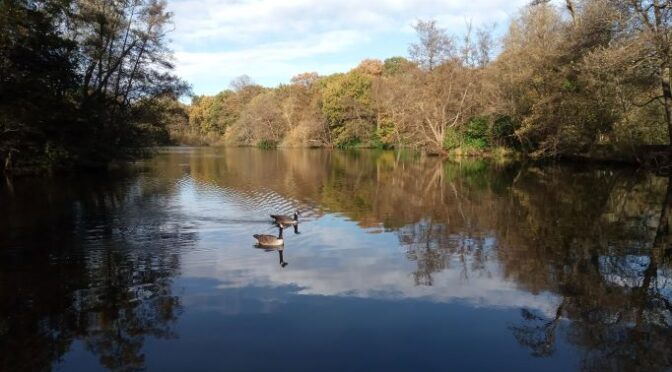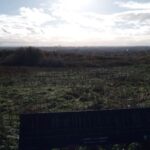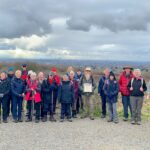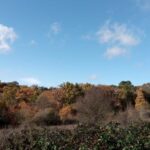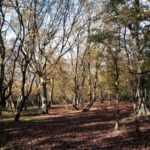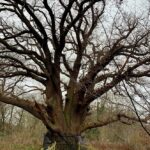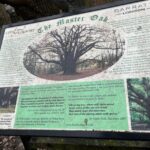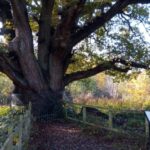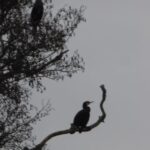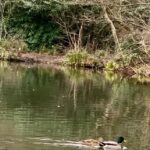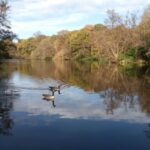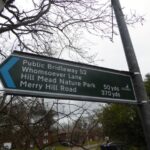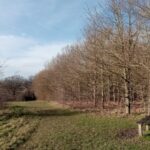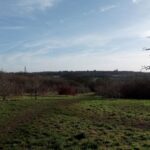We assembled outside Stanmore station, at the end of the Jubilee Line, on a cloudy but very mild winter’s day. This was an opportunity to explore three impressive almost adjacent nature reserves, Stanmore Common, Bentley Priory and Merry Hill and to discover some of their remarkable features and all this within easy reach
from Central London. Fortunately the dreaded mud factor at this time of year was not a huge issue thanks to recent dry weather.
With an 8 mile journey ahead we started keenly ,all 22 of us, and strode due north uphill from the station. After half an hour of moderate exertion though woods and grassland we climbed to Stanmore Common viewpoint which rewarded us with panoramic views to the south of the London skyline, a mere 12 miles away.
The leader then congratulated the group for reaching the highest point in Middlesex, a heady 505 feet above sea level. We learnt that the Common of 121 acres was owned and managed by Harrow Council in association with local volunteers and conservation groups. It consists of acid grassland, heath and woodland.
The common was never used for growing as the soil here was considered unsuitable for agriculture. Nevertheless it is the home of many rare plant species and rare insects. Animal life seen here includes muntjac deer, wood mice, voles and shrews.
We then headed downhill and traversed west to next on the list, to the wilds of Bentley Priory Nature Reserve. On entering we came to an almost hidden vast lake where we stopped for a short break by the water surrounded by mature trees such as Oak, Hazel, Hornbeam, Holly, Sycamore, Yew and Horse Chestnut.
This was the Summer House Lake so called as the widowed Queen Adelaide who lived at the nearby Bentley Priory mansion had a summer house built for her to overlook the lake and to savour its serenity. Queen Adelaide(1792-1849) was the widow of King William IV (1765-1836) and was quite a remarkable figure in her own right. As a tribute to her there are many places around the world named in admiration including the Australian City of Adelaide.
Bentley Priory Nature reserve is 160 acres and was designated as a Site of Special Scientific Interest by English Nature. The grassland has never been treated with fertilizer and cattle graze here at times to maintain the pastures and promote the rich diversity of wildflowers. Many interesting and uncommon birds can be seen or heard here amongst the grassland and woodland and in winter large numbers of birds migrate here from Europe and Scandinavia.
Birdlife also seen around the lake are Herons, Kingfishers and Mandarin Ducks.
We then repositioned through the woods to a very prominent landmark nearby, the Old Oak. This huge imposing Oak tree, now gnarled and weathered, is thought to be Middlesex’s oldest tree estimated at over 500 years old. One speculation is that this tree was but a tiny acorn during the reign of Henry VIII and is lucky to have survived the rampant felling to construct robust wooden Royal Navy warships. Oak was also much in demand for barrels, furniture and for the construction of sturdy barns.
We then exited Bentley Priory and aimed towards Bushey, and tramping via some quiet streets with their opulent housing we finally reached Merry Hill Nature Reserve. At 180 acres Merry Hill Nature Reserve was originally arable landscape but it is fairly new as it was only acquired in the late 1990’s by the Woodland Trust with the support of local like-minded communities. They immediately set about ambitiously transforming it. The landscape was changed by planting an awesome 60,000 additional trees, meadows were created, ponds restored, hedges planted, streams enhanced and as a result generated a rich and diverse habitat for wildlife. Birds seen here include skylarks and song thrushes and with the variety of grasses it encourages rare butterflies such as marble white and meadow brown.
The grand ambition with all these supplementary trees is that as they mature they will absorb more carbon dioxide and other green house gases and generate healthy oxygen creating one of the so called vital ‘green lungs’ around London.
After savouring all this clean air we alas then exited the reserve and rejoined reality and headed for the finishing point, the Load of Hay pub, for some nourishment and liquid sustenance. A chance to reflect on all we had seen and heard. All of this beauty and tranquillity virtually on our doorstep.
Les Filby. Photos by Les, Nita and Stuart

